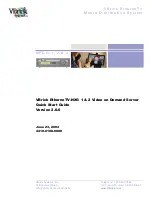
XT2+ Series DISK RECORDER - Version 10.05 - Hardware Technical Reference Manual
Issue
10.05.A
EVS Broadcast Equipment SA – July 2011
25
To avoid this phenomenon and provide a stable output picture, EVS developed 2
types of line interpolator: 2-line and 4-line interpolators. The interpolation process
can be enabled or disabled by the operator on all EVS slow motion systems.
2-
LINE
I
NTERPOLATOR
The 2-line interpolator actually generates a new field, when the original field is in
parity violation. Each line of this new field is calculated by a weighted average of
the 2 neighboring lines. This process solves the problem of parity violation and
vertical jitter, but the drawback is a reduction of the vertical resolution on the
interpolated fields, that appear unfocused. Another by-side effect is the
alternation of original fields (perfectly focused) and interpolated fields
(unfocused), resulting in a "pumping" video signal.
4-
LINE
I
NTERPOLATOR
The 4-line interpolator uses a more sophisticated calculation based on the 4
neighboring lines. By using suitable coefficients for the weight of each line in the
resulting calculation, we apply this interpolation to all fields. The final result is a
permanently, slightly unfocused picture. The advantage is a stable output signal
with no jitter and no "pumping", but the vertical bandwidth is even more reduced.
The interpolator is of course always disabled at 100% playback speed, because
there is no parity violation.
EVS use the same techniques with the Super Slow Motion disk recorder, working
with all models of Super Motion cameras (150/180 Hz). The only difference
between the processing of Super Motion and normal scan (50/60 Hz) signals is
that the interpolator is always disabled at 33% playback speed, because the Super
Motion signal does not cause parity violation at this particular speed.
Whatever the choice, the resulting picture is thus always a compromise between
stability and resolution. With EVS systems, the operator always has got the choice
between any of the 3 above described techniques: no interpolation, 2-line
interpolation or 4-line interpolation. Even if the operator chooses to use the
interpolation, this process will be automatically disabled when not necessary
(100% playback for 50/60 Hz signal, 33% and 100% playback for 150/180 Hz
signal).
Note
All professional VTRs use line interpolation in PlayVar mode to avoid
vertical jitters.
Default value is interpolator off for all configurations except SuperLSM
configuration in which 4-line interpolator mode is enabled.
Summary of Contents for XT2+
Page 1: ...Technical Reference Hardware Version 10 05 July 2011 Production Playout Server ...
Page 2: ......
Page 4: ......
















































